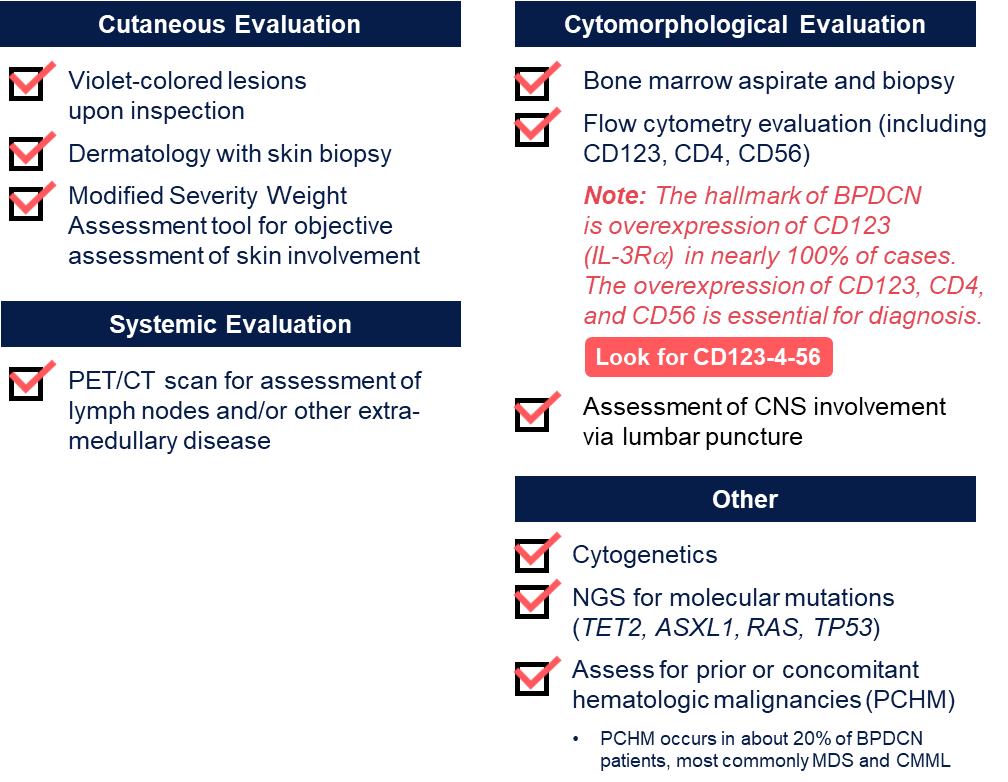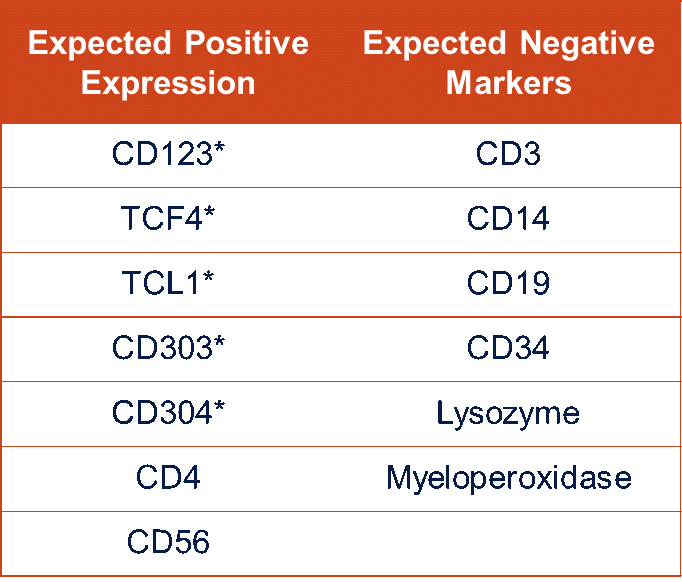BLASTIC PLASMACYTOID DENDRITIC CELL NEOPLASM (BPDCN)
Exploring dysfunctional pathways, mechanisms, and biomarkers in blastic plasmacytoid dendritic cell neoplasms
to discover new insights into the progression of the disease
Blastic plasmacytoid dendritic cell neoplasm (BPDCN) is a rare, aggressive hematologic malignancy derived from plasmacytoid dendritic cell precursors with skin, lymph node, blood, central nervous system (CNS), and bone marrow involvement.8 While BPDCN is currently considered a unique myeloid neoplasm, it had previously been classified as a subset of acute myeloid lymphoma (AML).9
Cytogenetic abnormalities are detected in 57%-75% of patients with BPDCN.10 Mutations occur via two main methods. First, a strong association with UV-induced mutation signatures has been observed in BPDCN.11,12 Second, sex-bias in mutations has been observed, as 3 times as many males are impacted by BPDCN as females. In particular, loss-of-function mutations in ZRSR2 (an X chromosome gene encoding a splicing factor) are enriched in BPDCN.12 In vitro, BPDCN is dependent on BCL-2 anti-apoptotic function for survival.13 Gene expression analysis demonstrated that BCL-2 was more highly expressed in BPDCN.14,15 CD123 is the alpha-subunit of the interleukin-3 receptor (IL-3Ra).16 All BPDCN cells express CD123 and CD123 is a clinically validated target in BPDCN.1
BPDCN is plasmacytoid dendritic neoplasm.17 Diagnosis involves cutaneous, systemic, and cytomorphological evaluations.1
Evaluations for Diagnosis
Patients typically present with diverse clinical features, including skin, bone marrow, blood, lymph node, and CNS involvement.8 Almost all cases present with cutaneous manifestations.6 In about half of cases, skin is the only site of initial disease.1 Clinical patterns can be divided into three major groups: nodules only (73%), bruise-like patches (12%), and disseminated and mixed lesions (14%).18 WHO immunophenotypic diagnostic criteria for BPDCN include expression of CD123 and one other pDC marker (*) in addition to CD4 and/or CD56 or expression of any three pDC markers and absent expression of all expected negative markers.17
Markers Used to Diagnose BPDCN
Initial treatment involves multi-agent chemotherapy or targeted therapy.1 Eligible patients are then considered for an autologous or allogeneic stem cell transplant (SCT).1
Clinical outcomes from BPDCN are challenging due to the aggressive nature of the disease, patients may not achieve response with frontline therapies and may experience relapse in both first and subsequent lines of therapies. BPDCN is associated with a poor prognosis, with median overall survival of approximately 8 to 18 months19 There are limited therapeutic options in BPDCN and not standardized treatment approach. Intensive treatments like chemotherapy and stem cell transplant may be options for eligible patients. Consequently, there is an urgent need for novel therapeutic approaches to improve outcomes. The rare and aggressive nature of BPDCN, complex pathogenesis, and wide spectrum of clinical manifestations makes diagnosis and treatment challenging. While historically BPDCN prognosis remains poor, ongoing research into novel treatment strategies are aimed at targeting specific disease markers to potentially improve patient outcomes.
CD123 (IL-3Rα) is ubiquitously expressed in BPDCN blasts but has limited expression on normal tissues, making it an ideal target agent for BPDCN.15,20 CD123 is already clinically-validated with an approved CD123-directed agent in BPDCN. Ongoing studies are exploring CD123-targeting therapies, and further research in this area is warranted
- Pemmaraju N, et al. Blood. 2023;141(6):567-578.
- Bueno C, et al. Haematologica. 2004;89(1):58-69.
- Laribi K, et al. Blood Adv. 2020;4(19):4838-4848.
- Sullivan JM, Rizzieri DA. Hematology Am Soc Hematol Educ Program. 2016;2016(1):16-23.
- Murthy GSG, et al. Leuk Res. 2018;73:21-23.
- Pagano L, et al. Haematologica.
- Poret E et al. Blood. 2015;126(23).
- Cascio MJ, et al. Precision Molecular Pathology of Myeloid Neoplasm.2017: 353-367.
- Vardiman JW, et al. Blood. 2009;114(5):937-951.
- Renosi F, et al. Cancers (Basel). 2022;14(17):4132.
- Griffin GK, et al. Nature. 2023;618(7966):834-841.
- Togami K, et al. Cancer Discov. 2022;12(2):522-541.
- Montero J, et al. Cancer Discov. 2017;7(2):156-164. 2. Sapienza MR, et al. Leukemia. 2014;28(8):1606–1616.
- Togami K, et al. Cancer Discov. 2022;12(2):522-541
- Jordan CT, et al. Leukemia. 2000;14(10):1777-1784.
- Wang W, et al. Haematologica. 2021;106(4):1047-1055.
- Khoury JD, et al. Leukemia. 2022;36(7):1703-1719.
- Julia F, et al. Br J Dermatol. 2013;169(3):579-586.
- Laribi K, et al. Blood Adv. 2020;4(19):4838-4848.
- Han L, et al. Cytometry A 2015;87:346-56.



